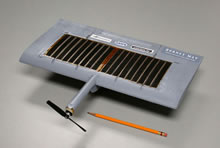Multifunctional structures will provide attractive benefits for UAVs, with unprecedented weight/power ratios. One approach studied by DARPA for multifunction structures is the monopolar proton exchange membrane fuel cell, which can be shaped into a UAV airfoil skin.
Monopolar fuel cells differ from bipolar (conventional) fuel cells by having the anodes of multiple cells sharing a common hydrogen filled internal volume as a manifold. The cell’s cathodes are the outer surface, open to the air. Individual cells are interconnected by metal conductive elements, with a single metal grid serving as the current collector and electrode support for the anode of one cell and the cathode of the next cell.
Fabricated multifunctional structures achieved an active fuel cells area of 85 % of the external surface, with an output of 1 W/gr. or 100mW/cm2). When applied to the skin, wings and antenna of the MAV, the generated power levels could be sufficient to power a MAV. By proper selection of materials, it can be sufficiently strong that no additional reinforcement is required.
Another feature of this multifunctional structure is the use of an integral metal grid, for effective electromagnetic insulation. Therefore, the structure can be used as an antenna, for communications or as part of a detector payload. Different approaches are used to develop multifunction structure plus power. A constant mass aerodynamic shape structure-battery is being developed based on Telcordia’s PLiONTM battery cells to be used in an AeroVironment’s Black-Widdow MAV. Another approach is studying constant shape autophagous (self consuming) structure fuel, consuming solid fuel elements which provide structural stiffness until they are transformed or consumed for propulsion. Other approaches consider Variform – variable mass structure-power, utilizing inflatable wing structure that collapses in a prescribed manner to maintain aerodynamic function.
Additional parts of this article:
















